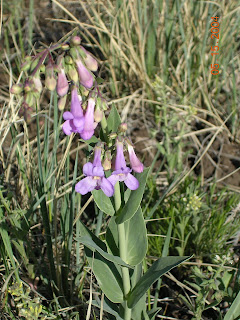You'll find some white Larkspur (Delphinium carolinium), which is taller than the purple Larkspur we had earlier in the Spring. These can stand 2-3' tall and may have small purple spots on them.
One of the cycles I've enjoyed watching this year is in a really simple group of daisies called the Fleabanes. They are in the Asteraceae (sunflower) Family and all are in the Erigeron species. They look nearly identical--small white daisies with yellow centers--but they have a few characteristics that distinguish them.
The earliest is Sprawling Fleabane, Erigeron tracyi, which is one of the earliest wildflowers. It has a very simple form, a stem that may reach 6" or so with one flower on the end. The leaves are nearly all basal. There may be a couple small ones near the base.
 |
| Sprawling Fleabane |
As the Sprawling Fleabane start to fade in the heat, Spreading Fleabane (Erigeron divergens). starts to bloom. These have flower heads that are slightly larger, but the plant is definitely bushier, with lots of leaves on the stems.
 |
| Spreading Fleabane |
If you go up on the trails right now, you'll see big patches of white Fleabane on the hillsides. These are Whiproot Fleabane (Erigeron flagellaris). These are the most interesting in the way they spread--they send out long stolons across the ground, which root to form new plants. Stolons are a type of stem that can form roots, and thus a new plant. This is why we see Fleabane in big patches this time of year.
 |
| Whiproot Fleabane |
Incidentally, the common names I give may vary depending on which guidebook you may be using. That's why I provide the genus and species name, too. Those should be more reliable, although they can change as DNA research turns up new twists in plant genealogy!









